The Bahlik region of northwestern India, which was extended in northern Afghanistan and Turkmenistan-Uzbekistan, had come under the control of the Greeks since the time of Alexander's invasion. This Bahlik region (Bactria) became the first Buddhist state in Central Asia. It was a political decision. Many states of modern Pakistan and Afghanistan became Buddhist religions or patrons of Buddhism during Ashoka's time. A large number of Hindus here also adopted Buddhism.
Greco-Bactrian Buddhist rule
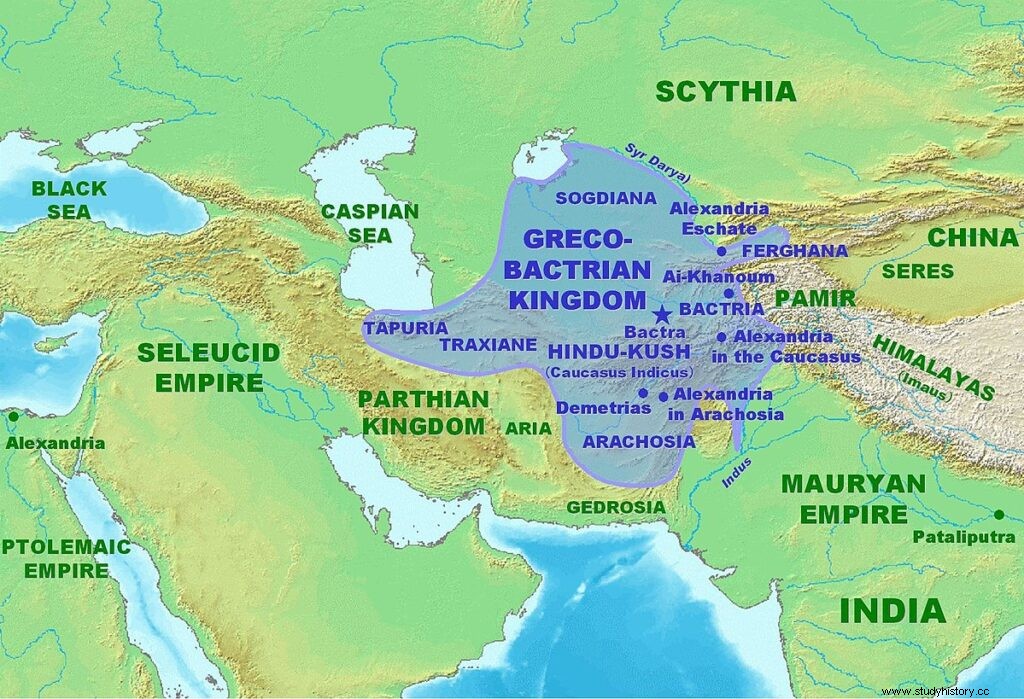
The Greco-Bactrian state was founded by Divodatta I (245–230 AD). In this lineage, Dimitri (Demetrius) became the next king, who was the son-in-law of the grandson of Seleucus and the son of Chandragupta Maurya. Whether he himself was a Buddhist or not is not clear, but he was the patron of Buddhism, probably he built the city of Termiz and the Buddhist monastery there. Due to the weak Maurya rulers of Magadha, it invaded India to take control of the Maurya Empire and was successful to some extent. Minander was its commander. (History of Central India, author-Rahul Sankrityayan)
When Minander became the Greek ruler of the region of Bahlik, he thought of completing the unfinished work of Dimitri. By taking advantage of the non-violent, weak and ignorant rule of Magadha, he wanted to conquer the Indian territory across the Indus river with the support of the Buddhists of northwestern India, so he too became a Buddhist. But there was a change of power in Magadha and the mighty Pushyamitra Shunga took over. Therefore, with the help of Buddhists, Minander was able to penetrate deep into India, but Pushyamitra Shunga pushed him back to Bactria (Bahlik). In history, they are called Greco-Bactrian Buddhists. Initially, through these Buddhism spread in Central Asia. Buddhism was also spread in Greece by these Greco-Bactrian Buddhists.
Kushan power over Greco-Bactrian kingdom
In 135 BC, the Kushanas occupied the northern and southern Hindu Kush mountain regions of the Vaksh river (modern Amu Darya) in the Hindu Kush mountain region. After Alexander's invasion of India in 327 BC, the Greeks settled here and they called this area by the name of Bactria.
Bactria was first attacked by the Shakas, then while driving the Shakas and the Greeks, the Kushanas defeated the Greeks and snatched the power of the Bahlik kingdom. Kujul Kadphisus (30 AD to 80 AD) is considered the founder of the Kushan dynasty. According to the Chinese historical text Hou Hanshu, the Kushan chieftain Kujul Kadphisus conquered the Kapisha and Gandhar kingdoms in the south of the Bahlik region. Kapisha was a prestigious state. The kingdom of Kapisha was named after its famous city and capital 'Kapisha'. This city was located 50 miles north of Kabul. (Wikipedia)
The spread of Buddhism by the Kushanas

The Indian name of Kujul Kadphisus was Gujur Kapisha (a resident of Kapisha). He was a believer of Shaivism. Being a Hindu, there was also a feeling of equality of all religions in him. Therefore he also patronized Greek, Buddhist, Zarathusta religions. This region was under the control of the Greeks for about 350 years, so the Kushanas also have a great influence of Greek religion, culture, language and costume.
The political culture and language of the early Kushanas probably remained Greek, later Sanskrit-Bahlik and the script Kharoshti-Brahmi. His grandson's name was Bhima Kapishiya (Veem Kadphisus) and he was also a Shaivite. The son of this was the famous king Kanishka, who adopted Buddhism following the policy of Minander and ruled modern Pakistan, Afghanistan, South-Central Asia, Xinjiang and even some parts of India beyond Sindh.
(Shakas, Kushanas and Huns were of Hindu Kshatriya lineage, this will be put forward with detailed proof in a separate article)
The spread of Buddhism by the Sassanid Kshatriyas of Iran
In the third century, the Zarathustra righteous Sassanid Kshatriyas of Iran defeated the Kushanas and occupied the Bahlik region. In the beginning, he opposed the Buddhists and emphasized on Zarathustra religion, but later he built many Buddhist monasteries. During his time, huge Buddhist statues were built in the hills of Bamiyan. Buddhism and Zoroastrianism got so mixed together that a new deity "Buddha-Majda" was formed like the Ahurmajda of the Zoroastrians.
The spread of Buddhism to Central Asia by the Huns
In the fifth century, the Sanskrit-Turkish (Chorasmian) speaking Huns conquered the whole of Central Asia and established a vast empire which extended from the Caspian Sea to Kashgar and the Aral Sea to Sindh of India. In short, they were the Kshatriya dynasty of Madra and Salva during the Mahabharata period. He did not tinker much with the Buddhist kingdoms of Sogdiana, especially Samarkand. He also gave shelter to Buddhism and built many Buddhist temples. During this time, the spread of Buddhism was to the Tarim Basin of China. The Saka kingdoms of Khotan, Yarkand and Kashgar had already become Buddhist. These trade routes were extended on the Silk Route, so their trade was advanced.
Eastern Hun and Turkish Buddhist
According to Chinese sources, the Turks and Tatars were descendants or branches of the Eastern Huns, whose old name was Ashwasena. The Huns, who came out of China Mongol, took possession of Middle East Asia, pushing the Kushanas and Shakas towards the west. The descendants of these or a tribe descended from them later came to be called Turks. The Turk Toba Khaqan (Khan) embraced Buddhism in 570 AD and after that the Turks tried to become non-violent. Many Buddhist stupas and monasteries were built by Toba Khan.
Due to not being able to become Kagan (King) due to birth of a Sardar of these Turks from a woman of low caste, Dalobyan, established a separate Turk state, which is known as Western Turk. He ended the White Huns and established the Ottoman Empire in Central Asia as well. They also adopted Buddhism and preserved and developed Buddhism. (History of Central India, author-Rahul Sankrityayan)
During his time Buddhism had spread from Central Asia to Chinese Turkestan and modern entire Xinjiang Province (Uyghur Buddhism), including Zoroastrians, Aryadharmis (Hindus) and some Christians as well.
Samarkand city is ancient Markandeya city
According to the Greek historian Orion, Markand was the capital of Sagadiana. Markand is probably the same city that the Iranian people today call Samarkand - Sir W Drummond's book page 322
Markande is actually Markandeya i.e. the old name of Samarkand city was Markandeya Nagar because there was ashram and Gurukul of Rishi Markandeya. Sagadiana Rajkul is an ancient word of purification. Samarkand was a Buddhist city before the Muslims took over Samarkand and the king here was also a Buddhist. The palace of the last Buddhist king is now called the tomb of Timur Lang - P N Oak
Sir W Drummond has mentioned, "A lion surmounted by the solar orb, was the device of the ancient monarchs of India."
The same sign is inscribed on both the upper corners of the entrance of that huge palace in Samarkand, which is called the tomb of Timurlang. This shows that the acquired palace in which Timurlang lived and now his tomb is a building of ancient Kshatriyas. In both its corners "Row Regalia" is inscribed. The guides there call him Sursadool and confess that they do not know its meaning.
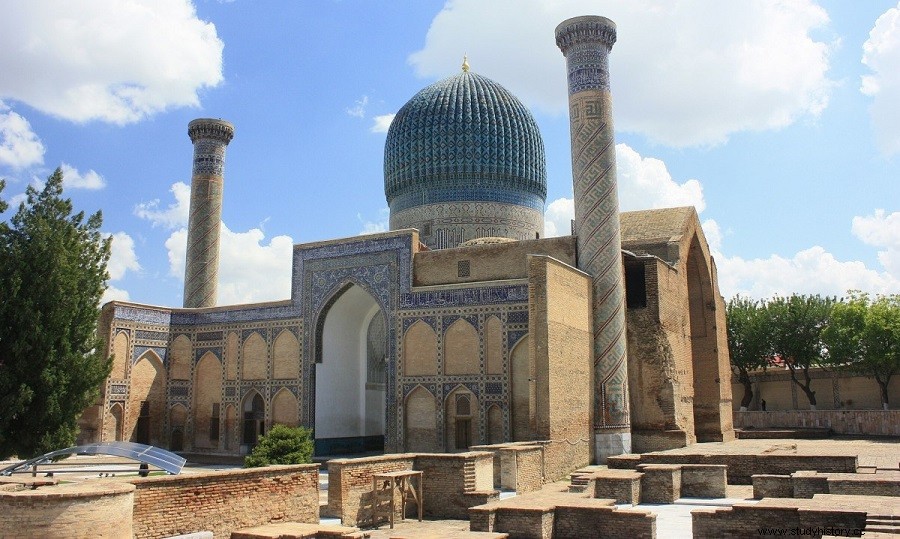
Soorsadool is actually the word Suryashardul which is derived from the word Surya and Shardul which means lion. Surya indicates the might of the dynasty Kshatriyas. Sanskrit words and Kshatriya symbols are clear evidence that the tomb of Timur is the palace of the ancient Hindu royal family. In the Bikaner princely state of India's Suryavanshi Kshatriyas, the sports club of the king and courtiers was called Sadool Club. (Credits History of Vedic Vishvarashtra Part-2) It is clear from the above that the people of Sogdiana were Hindus before they became Buddhists.
Hindu-Buddhist sites of Central Asia
If you go to any tourism website of Uzbekistan, then you will get a tour package of 11-12 days Buddhist route tour. This journey starts from Tashkent and goes back to Tashkent via the Buddhist region Termiz-Samarkand-Bukhara-Khiva-Nukus. To visit Buddhist sites, it is necessary to get permission from the Uzbekistan government 15 days in advance.
Kara-Tepe
The Buddhist site Kara Tepe is located on three hills to the north-west of the city of Old Termiz. There are many temples and monasteries here which were built in the second century or earlier. This Buddhist site was the most famous in the second and third centuries AD and worshiped here till the sixth century AD. Arab invaders destroyed and corrupted these along with other Buddhist sites and temples, but still the remaining Hindus, Buddhists who had accepted to pay tax in return for living, used to come to this place to worship by paying special religious taxes, but time With that they were also destroyed and the place was merged into the depths of the past. The Buddhist abbots here went to Kashmir, where the Karkot dynasty was ruled by Hindus and who were also the guardians of the Buddhists. (Wikipedia)
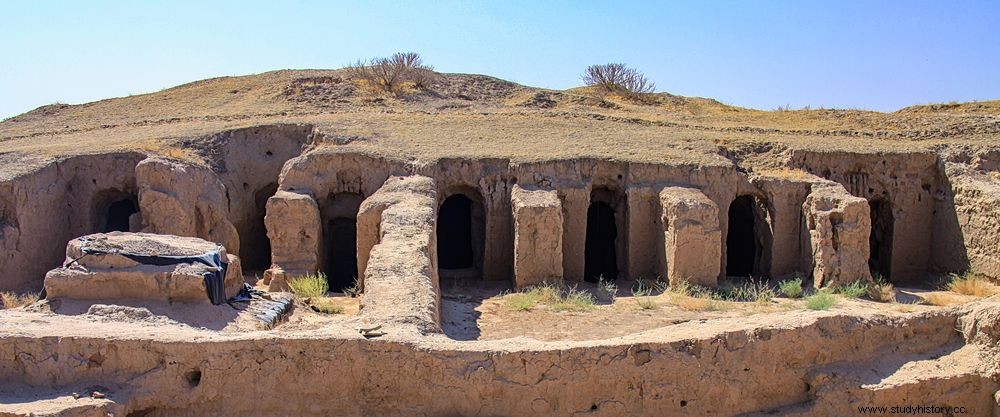
Russian archaeologists excavated in Kara Tepe, Uzbekistan, whose report was published in the Indian Express daily on November 27, 1983. In it, reporter SK Malhan writes, "Excavation in the Kare Tepe hill near Termez (ancient city) in the South Uzbek place of Russia revealed another thread of ancient cultural relations between Soviet Central Asia and India.
A traveler named Huai Tsao reached the village of Termez in 728 AD. He has written the memoirs of that meeting. According to him the king and subjects of Hua-To-Lo (Huttal) were Buddhists. There were many Buddhist viharas in that region. An ancient document describes the restoration of some Buddhist temples in Samarkand in the middle of the 7th century.
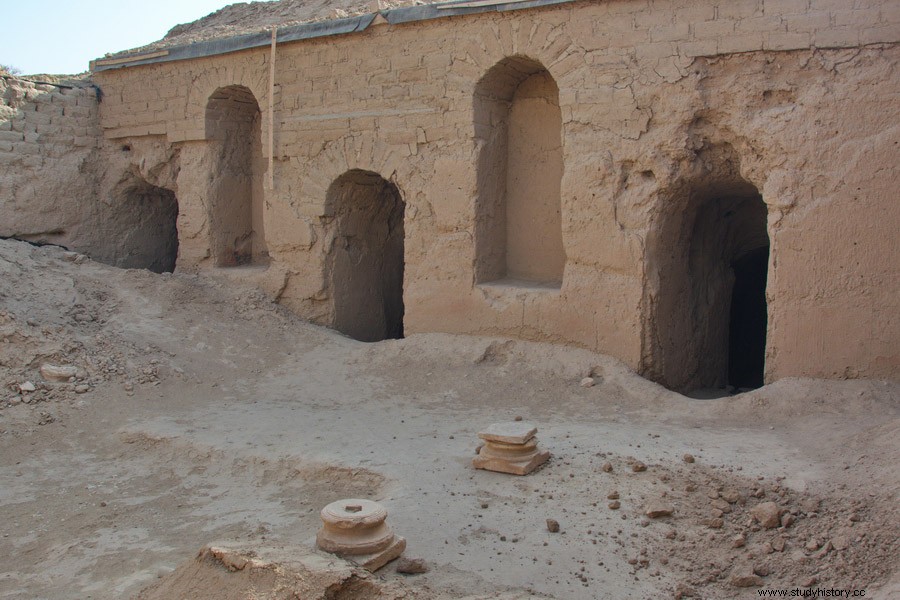
Excavation has only been done in the south front of that hill with three peaks, however it is clearly visible from it that there are dozens of different viharas in that Buddhist center. Many caves and temples, chambers, auditoriums etc. have been built in each. They have two rows at many places. In some monasteries there are stupas and in some places there were pillared halls which were called Awan. Those caves, temples and awans are often decorated with colorful paintings. The images are either of gods or of donors or from the context of mythology.
Historian PN Oak writes, "Inscriptions of various languages and scripts have been found in Kara Tepe. Some of them are in Kushan script with Greek alphabet, in Brahmi, in Kharoshthi in Central Iranian script and in Aramaic script. The Buddha statues there are like Indian Buddha statues.
Fayaz-Tepe, Termez
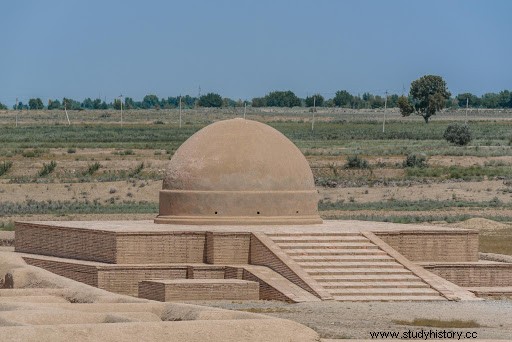
The Buddhist site Fayaz Tepe was discovered by the archaeologist El Albaum during the excavations of the hills near Kara Tepe in 1963. This temple complex is full of exquisite paintings and sculptures. The complex is in a U shaped series consisting of room, verandah, sanctum sanctorum. There is also a Buddhist Dagoba here which is the center of special attraction.

The Buddha statues found from here are seated under the sacred Bodhi tree and two Buddhist saints are standing on either side. The idols are made of limestone and are covered with gold plate. Today it is the most valuable statue on display in the State Museum of History of Uzbekistan. A huge Buddhist dagoba, ten meters high, has been found near the temple. Apart from this, a small dagoba, three meters high, has also been built. This is from the first century AD. (Wikipedia)
Gyaur-Kala – The Fortress of Infidels
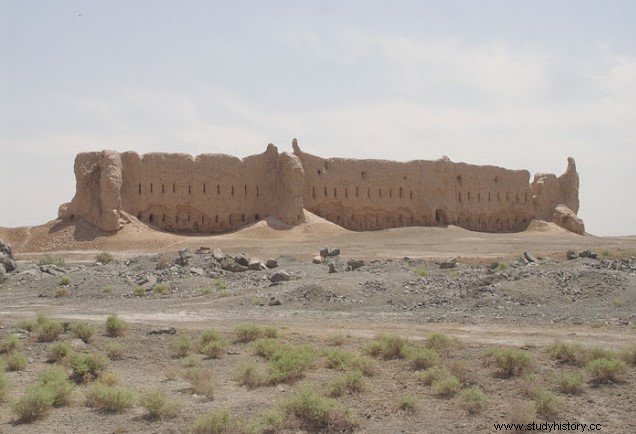
Gyur-Kala is located in Karakalpakstan, now Nukus in modern Uzbekistan, which is part of ancient Khorasan whose capital was Nishapur. It was a city located on the Silk Route, which was probably called Nishapur due to being the most suitable place for night rest.
Arabic invaders destroyed it and started calling it Gayur-Kala meaning "Fort of Godsmen" and today it is known by this name. This fort was probably built in the fourth century. Its wall is ten meters high. It is surrounded by two small forts, one of which is a temple and the purpose of the construction of the other is not clear. Possibly the second fort may have been built for the protection of the temple. It is believed that Jarthrustha, the brother-in-law of the sage Bhriguvanshi Rijrasva, composed the Zenda Avesta text in this area.
The Fortress of Lost Ram
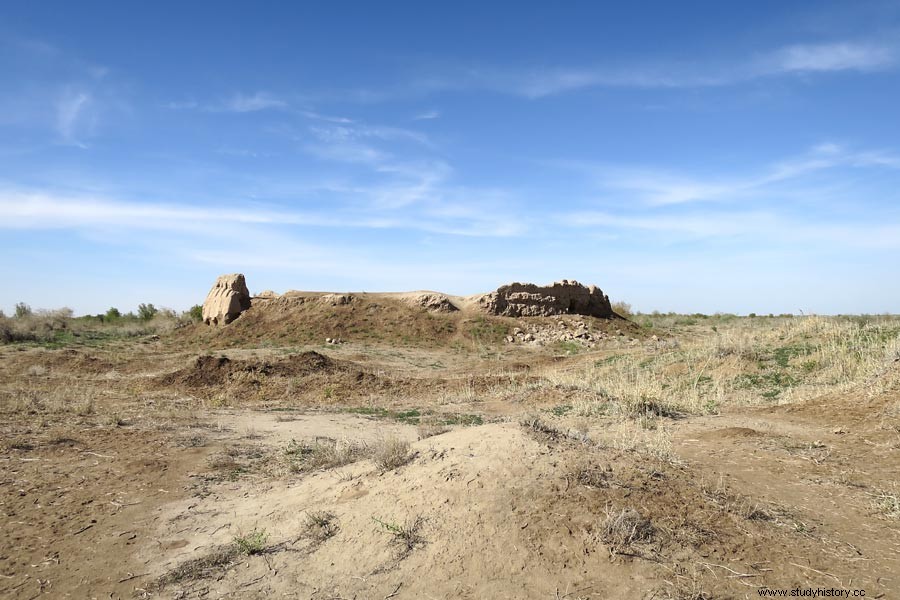
The Fortress of Lost Ram was discovered in 1938. It was a mighty circular fort with a small fort inside it. The diameter of the outer fort was 90 meters and the diameter of the inner fort was 42 meters. Thousands of pottery, bronze pointed arrows etc. have been found from here. According to archaeologists, this is the oldest memento of ancient Khorasan.
Excavations done in 1950 show that this construction is two tier. पहली बार सम्भवतः पहली शताब्दी में निर्मित हुई और दूसरी बार तीसरी चौथी शताब्दी में. खोरासन के इस सबसे प्राचीन किले के एक हिस्से में मन्दिर बना है और एक हिस्सा सम्भवतः प्राचीन राजा-रानी के शवगृह के रूप में प्रयोग किया जाता था. किले में रहने वाले लोग नदी देवी अनाखिता और सूर्य देवता सियावुस कि पूजा करते थे. मन्दिर का पश्चिमी हिस्सा में अनाखिता देवी का मन्दिर था और पूर्वी हिस्से में सूर्यदेवता सियावुस का जो वहां मिले असंख्य वर्तनों और अवशेषों पर देवताओं के मिले चित्रों से पता चलता है. यह किला अब तक एक ऐतिहासिक पहेली बना हुआ है, जो प्राचीन खोरेज़म के अन्य किलों के बीच अपने अद्वितीय डिजाइन के साथ खड़ा है.
(Source:https://www.advantour.com/uzbekistan/karakalpakstan/koy-krylgan-kala.htm )
उपर्युक्त के सम्बन्ध में लेखक की राय
खोरासन प्राचीन मद्र राज्य का हिस्सा था और देशी विदेशी इतिहासकारों के अनुसार यह क्षेत्र २५०० ईस्वी पूर्व तक वैदिक हिन्दुओं का गढ़ था, सातवीं शताब्दी तक यहाँ बौद्ध, हिन्दू और जरथ्रुष्टधर्मी लोग रहते थे. इसलिए मेरा मत है किले के भीतर जिस सूर्य देवता और अनाखिता देवी कि बात कि जाती है वह वास्तव में श्रीराम और सीता देवी का मन्दिर हो सकता है. इसीलिए यह किला The Fortress of Lost Ram के नाम से आजतक जाना जाता है.
“सियावुस” जिसकी पहचान सूर्य देवता के रूप में की गयी है वह “सूर्यवंशी सियापति” अर्थात श्रीराम हो सकते हैं. परवर्ती काल में इस क्षेत्र के जोराष्ट्रीयन प्रभाव में आ जाने के कारण सीता देवी को अनाखिता देवी मान लिया गया लगता है और सियापति को सियावुश जबकि जोराष्ट्रधर्मी के सूर्य देवता ‘मित्रस’ कहलाते थे और प्राचीन मध्य एशिया में सूर्य देवता ‘सवित्र’ कहलाते थे.
आधुनिक ऐतिहासिक शोधों में इराक और ईटली में भी रामायण प्रसंगों के पेंटिंग्स और पहाड़ कि गुफाओं में मूर्तियाँ उत्कीर्ण मिली है. मध्य एशिया का यह हिस्सा तो प्राचीन भारतवर्ष का हिस्सा रहा है. इसलिए यहाँ श्रीराम सीता का मन्दिर आश्चर्य कि बात नहीं है. उन्ही कि यादें Fortress of Lost Ram में अभी तक जिन्दा है.
“ईरान, कोल्चिस और आर्मेनिया के प्राचीन नक्शे से उन प्रदेशों में भारतीय बसे थे इसके स्पष्ट और आश्चर्यकारी प्रमाण मिलते हैं. और रामायण तथा महाभारत के अनेक तथ्यों के वहां प्रमाण मिलते हैं. उन सारे नक्शे में बड़ी मात्रा में उन प्रदेशों में भारतियों के बस्ती का विपुल ब्यौरा मिलता है” (पेज ४७, इंडिया इन ग्रीस, लेखक एडवर्ड पोकोक)
तो प्राचीन मद्र राज्य का हिस्सा उज्बेकिस्तान में श्रीराम सीता का मन्दिर होना कोई बड़ी बात नहीं लगता है. वहां से उत्खनन में मिले प्रमाणों में ‘तीर’, ‘राम’ और ‘सिया’ शब्द भारतवर्ष के राम सीता से सम्बन्धित हैं.
यह किला जोराष्ट्र पंथी हिन्दुओं का नहीं था यह इस बात से भी पुष्ट होता है कि जोराष्ट्र पंथी हिन्दू शव दाह या दफन नहीं करते थे बल्कि वे शव को खुले में छोड़ देते थे ताकि पशु-पक्षी उनका भक्षण कर सकें और उनके मृत शरीर भी किसी के काम आ सके. परन्तु किले के एक भाग में राजा रानीयों के लिए शवदाह या शवगृह होना उन्हें जोराष्ट्रपंथी से अलग करते हैं. संभवतः ऐसे ही अन्य विशेषताओं के कारण पुरातत्वविद इसे, खोरासन जिसे हजारों किले का प्रदेश कहा जाता है, उन सबसे बिलकुल अलग और विचित्र मानते हैं.
अन्य हिन्दू, बौद्ध स्थल
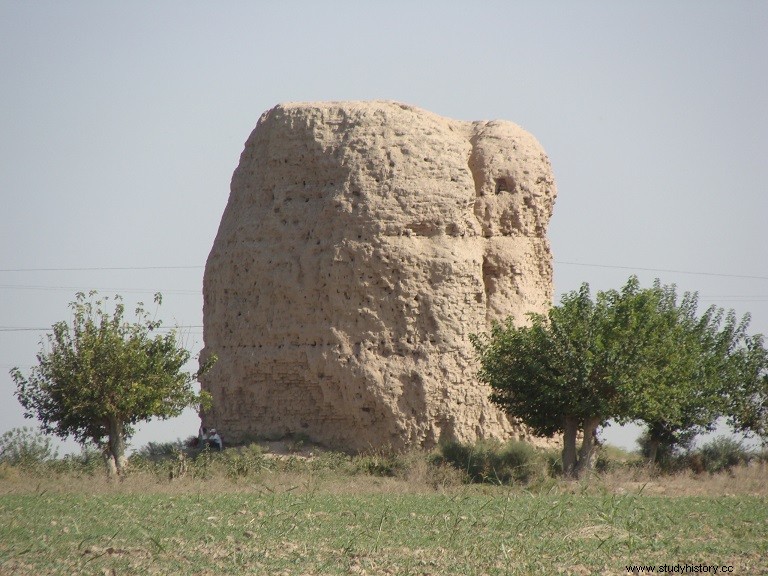
चीनी तुर्किस्तान में ओल्डेनबर्ग को सहस्त्र बुद्ध मूर्तियों वाली एक गुफा का पता लगा. इस गुफा कि छत और दीवारों पर रंगीन चित्रकारी है, दीवारों पर कई वैदिक देवी देवता दर्शाए गए हैं.
Kurgan-Tube नाम का एक नगर उस प्रदेश के Vakhash घाटी में है. उस नगर से १० किलोमीटर दुरी पर Arin_Tepe स्थान पर एक प्राचीन मठ पाया गया. वहां पर एक विशालकाय मूर्ति का टुटा हाथ पड़ा है. उसका केवल एक अंगूठा ही पूरे जीवित मनुष्य के आकर का है. Kurgan कुरुगण शब्द है. जिस विशालकाय मूर्ति का टुटा अंगूठा वहां है वह भीम कि मूर्ति हो सकती है.
तुर्कमानिया प्रदेश के Merve गाँव में एक प्राचीन मन्दिर पाया गया. उसमें एक स्तूप, एक मठ और एक गर्भस्थान बना हुआ था. स्तूप पर चढ़ने केलिए एक सीढ़ी बना हुआ है. उस मन्दिर में बनी मिटटी कि एक विशाल बुद्ध मूर्ति इस्लामी आक्रमणकारियों ने नष्ट कर दी.
करधाना (उज्बेकिस्तान) प्रदेश के Kuva गाँव में एक प्राचीन मन्दिर पाया गया जिसमें एक विशाल मूर्ति के ललाट पर तीसरी आँख भी है. पुरातत्वविद उसे बुद्ध कि मूर्ति कहते हैं जो सम्भवतः भगवान शिव कि मूर्ति है. (वैदिक विश्व राष्ट्र का इतिहास, लेखक-पी एन ओक)
